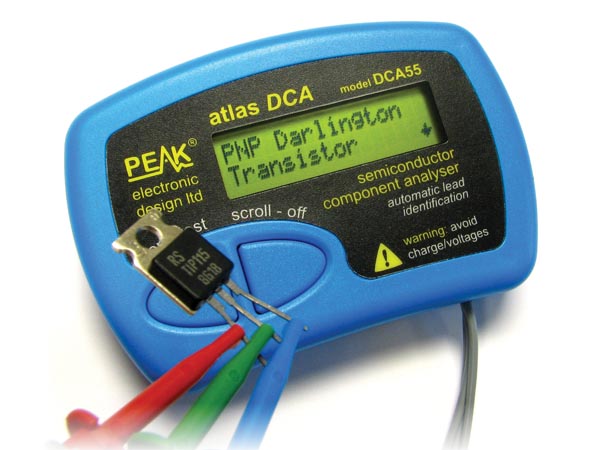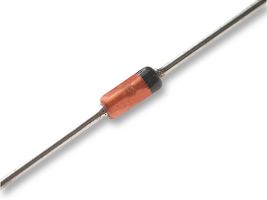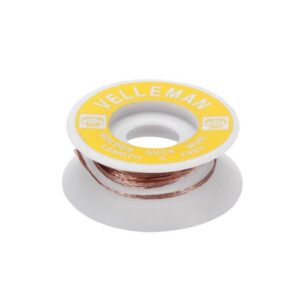Beskrivning
DCA55 är en smart mätinstrument för många typer av halvledare.
Instrumentet är enkelt att använda och kan automatiskt identifiera komponenter och pinout.
Komponenter som kan testas:
* Bipolära transistorer
* Darlingtontransistorer
* FET-transistorer
* Triacs
* Tyristorer
* Dioder och lysdioder
Funktioner:
* Förstärkning- och läckströmssmätning för transistorer
* Detektering av typ för transistorer (kisel / germanium)
* Gate-threshold-mätning för FET-transistorer
* Spänningsfall för dioder och transistorer
>> Datablad
>> Manual
Mer data se nedan:
Intelligent and flexible semiconductor analyser. Connect any way round! The DCA55 then displays the following:
- Component type (such as NPN transistor, P-Ch MOSFET, LED, diode etc)
- Pinout information (such as Base, Emitter, Collector etc)
- Parameter measurement (hFE, Vbe, Vf, leakage current etc)
Supports transistors MOSFETs, JFETs (gate pin only can be identified), diodes, LEDs and lots more. Automatically identifies type of component, pinout and other important parameters.
Now features transistor leakage measurement and Germanium/Silicon identification.
Includes:
- DCA55 Semiconductor Component Analyser instrument.
- Comprehensive illustrated user guide.
- Fitted universal hook probes.
- AAA Alkaline battery.
Technical Specifications
General specifications:
Test current (into short circuit): ±5mA (typical)
Test voltage (into open circuit): ±5V (typical)
Component Support
- Bipolar transistors (NPN/PNP inc Silicon/Germanium)
- Darlington transistors (NPN/PNP)
- Enhancement mode MOSFETs (N-Ch and P-Ch)
- Depletion mode MOSFETs (N-Ch and P-Ch)
- Junction FETs (N-Ch and P-Ch). Only gate lead identified.
- Diodes and diode networks (2 and 3 lead types).
- LEDs and bi-colour LEDs (2 lead and 3 lead types).
- Low power sensitive Triacs and Thyristors (<5mA trigger and hold)
Measurements
-
- Part type identification.
- Pinout identification.
- BJT current gain (hFE).
- BJT base emitter voltage (Vbe).
- BJT collector leakage current.
- MOSFET gate threshold voltage.
- Diode forward voltage drop (Vf).
FAQs
Q. Is the DCA ok with germanium transistors, can it measure leakage current and does it take into account the leakage current for it’s gain measurement?
A. Yes. The DCA will detect the germanium (or silicon) type of semiconductor. It will measure leakage current and it takes that leakage into account when measuring gain (unlike most multimeter hFE measurements).
Q. I’ve noticed the leakage current of my germanium transistor gradually drop with each subsequent measurement. Is something wrong?
A. Leakage current is extremely temperature dependent and particularly noticeable for germaniums as the current is fairly high to start with. The leakage current can double for just a 5°C increase in temperature. So after some handling, the transistor temperature slowly falls and can lead to a decreasing leakage current. That’s completely normal and correct.
Q. The Collector and Emitter of my germanium transistor is showing the wrong way round, is the DCA55 wrong?
A. If the leakage current of the germanium transistor is quite high (due to warming from your fingers for example), the DCA55 can reject the ”correct” pinout. However, it will then search for all other device types and configurations. It can, in those circumstances, find a transistor of opposite type (NPN/PNP) and with the C-E swapped (although gain can be very low). Tests in a simple circuit confirm that you can get a germanium transistor to work, with some gain, in that way. So the DCA55 is not wrong, it’s just found a configuration that yields a low leakage current. Try keeping your transistor cool during testing to avoid this situation.
Q. Can the Atlas DCA measure Zener diodes? Perhaps low voltage ones?
A. No, the DCA doesn’t currently support Zener diodes. Low voltage (<5V) zener diodes can lead to confusing results although the displayed forward voltage may represent the Zener voltage which can be useful. Higher voltage Zeners (>5V) will be shown as a regular diode and the forward voltage will be the voltage of the pn junction not the zener voltage). Take a look at the Atlas ZEN.
Q. Can I use the DCA to match transistors?
A. Yes. The main parameters that you may be interested in are hFE and Vbe. Both of these parameters are measured by the DCA.
Q. What will the DCA show if my component is faulty?
A. Generally, the DCA would show ”Faulty or unknown component”. Sometimes it may still be able to see a pn (diode) junction within the component you’re testing, in which case it would display ”Diode or diode junction(s)”. If there is a short circuit within your component then the DCA will display ”Short circuit on RED GREEN” for example.
Q. Can my Atlas DCA be upgraded online?
A. The only way to upgrade the firmware is to send your unit to us. It’s a very low cost process. See our Support section.
Q. What is the latest version of the Atlas DCA?
A. The latest firmware version is 4.1.
Q. Why can’t the DCA analyse triacs or thyristors that need higher currents than 5mA?
A. The test currents of the Atlas DCA are deliberately kept below 5mA to avoid damage to any potentially random component that can be connected any way round. The Peak Atlas SCR is aimed specifically at analysing a wide range of triacs and thyristors that require gate test currents from less than 100uA up to 90mA.






